CORP/BUSS LAW Assignment: Consumer Rights, Negligence Analysis
VerifiedAdded on 2023/04/04
|9
|1798
|268
Report
AI Summary
This assignment addresses two legal questions. The first analyzes whether James can get a refrigerator replaced under Australian Consumer Law after the manufacturer's warranty expired, concluding that implied warranty covers him. It advises James to contact the seller or manufacturer for a refund, replacement, or repair, irrespective of the retailer's return policy. The second question examines whether Sarah is liable for negligence after colliding with Jason, a cyclist riding at night without lights or reflective gear. Applying the Civil Liability Act, the assignment argues that Sarah was not negligent as she was driving attentively and within the speed limit, while Jason's actions violated cycling rules, creating an obvious risk. The conclusion is that Jason is responsible for the collision due to his negligence.
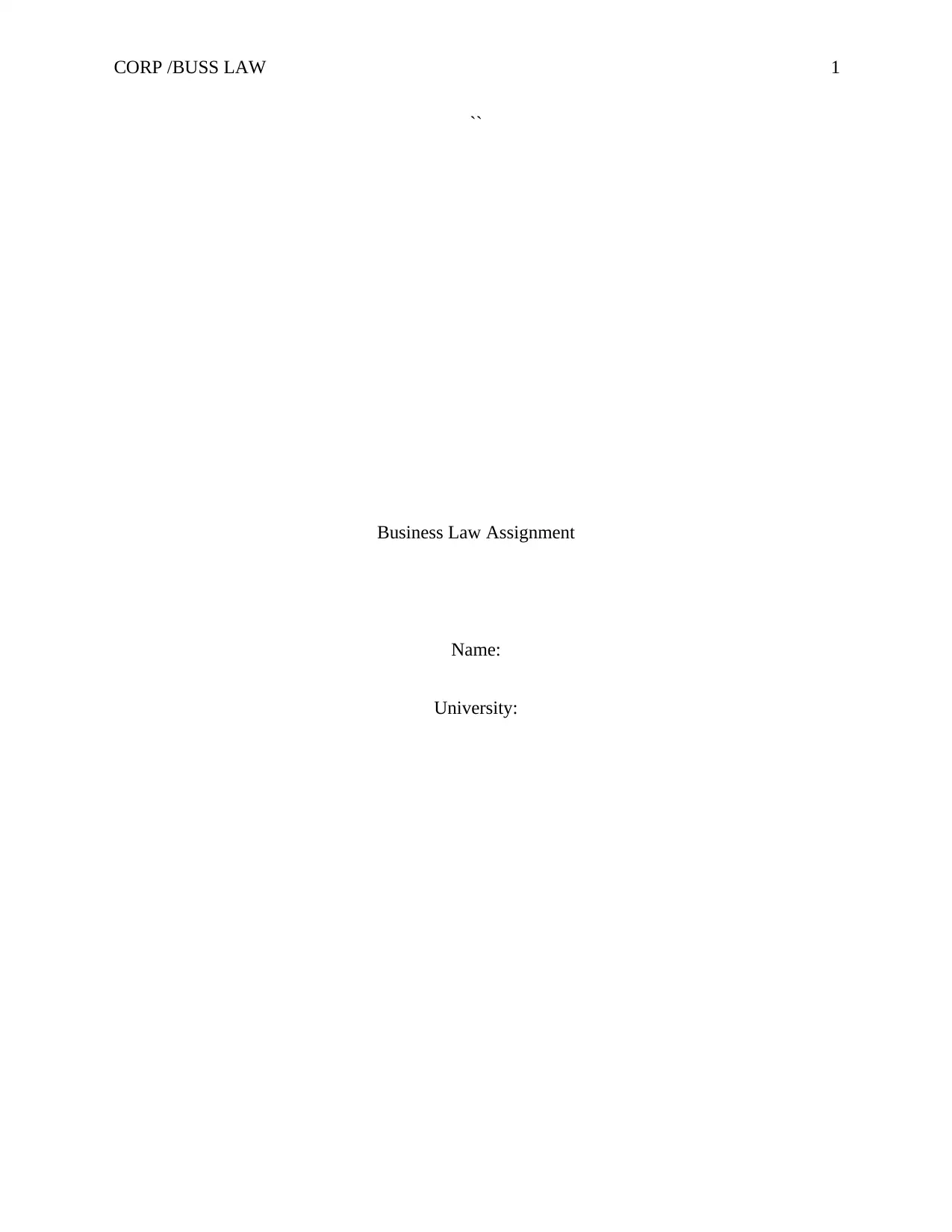
CORP /BUSS LAW 1
``
Business Law Assignment
Name:
University:
``
Business Law Assignment
Name:
University:
Paraphrase This Document
Need a fresh take? Get an instant paraphrase of this document with our AI Paraphraser
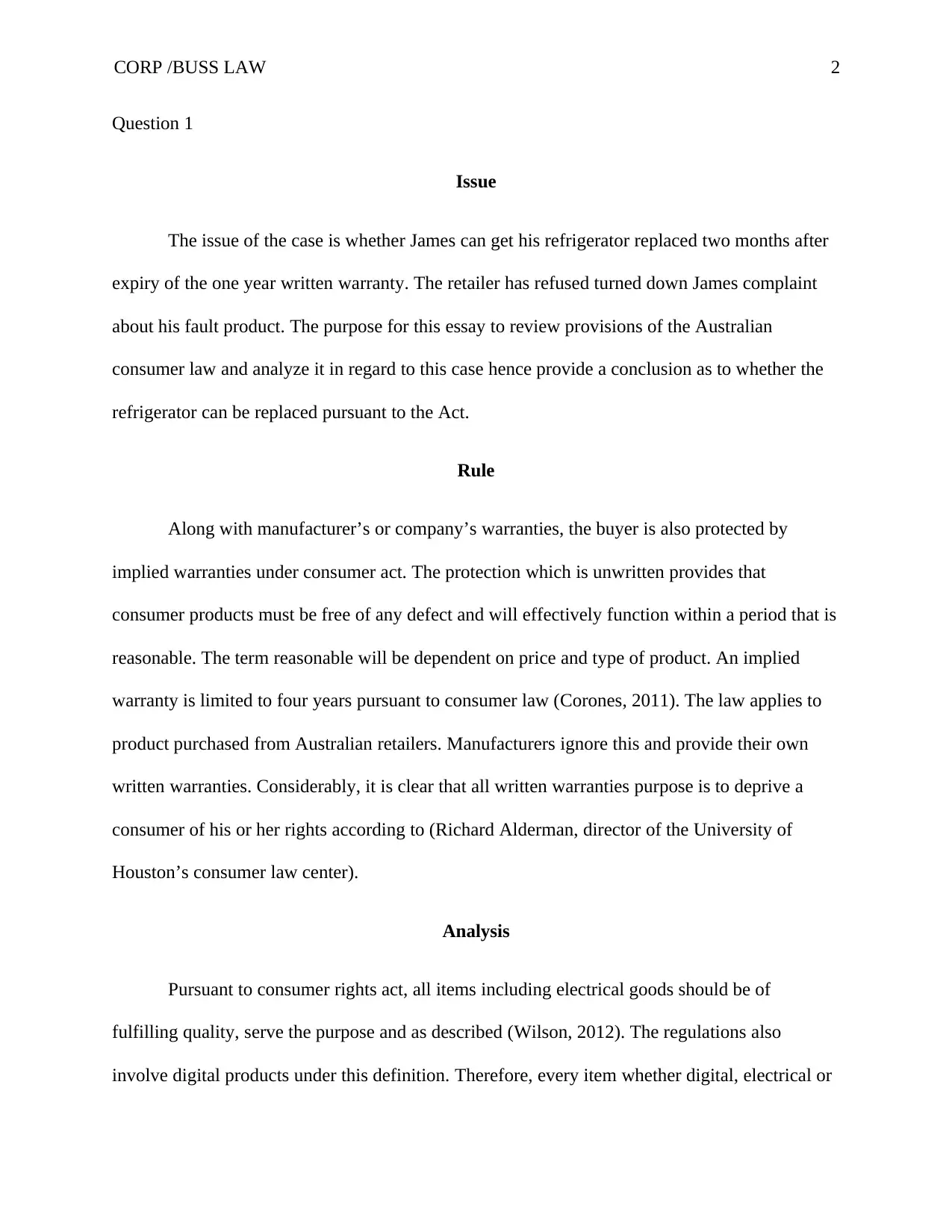
CORP /BUSS LAW 2
Question 1
Issue
The issue of the case is whether James can get his refrigerator replaced two months after
expiry of the one year written warranty. The retailer has refused turned down James complaint
about his fault product. The purpose for this essay to review provisions of the Australian
consumer law and analyze it in regard to this case hence provide a conclusion as to whether the
refrigerator can be replaced pursuant to the Act.
Rule
Along with manufacturer’s or company’s warranties, the buyer is also protected by
implied warranties under consumer act. The protection which is unwritten provides that
consumer products must be free of any defect and will effectively function within a period that is
reasonable. The term reasonable will be dependent on price and type of product. An implied
warranty is limited to four years pursuant to consumer law (Corones, 2011). The law applies to
product purchased from Australian retailers. Manufacturers ignore this and provide their own
written warranties. Considerably, it is clear that all written warranties purpose is to deprive a
consumer of his or her rights according to (Richard Alderman, director of the University of
Houston’s consumer law center).
Analysis
Pursuant to consumer rights act, all items including electrical goods should be of
fulfilling quality, serve the purpose and as described (Wilson, 2012). The regulations also
involve digital products under this definition. Therefore, every item whether digital, electrical or
Question 1
Issue
The issue of the case is whether James can get his refrigerator replaced two months after
expiry of the one year written warranty. The retailer has refused turned down James complaint
about his fault product. The purpose for this essay to review provisions of the Australian
consumer law and analyze it in regard to this case hence provide a conclusion as to whether the
refrigerator can be replaced pursuant to the Act.
Rule
Along with manufacturer’s or company’s warranties, the buyer is also protected by
implied warranties under consumer act. The protection which is unwritten provides that
consumer products must be free of any defect and will effectively function within a period that is
reasonable. The term reasonable will be dependent on price and type of product. An implied
warranty is limited to four years pursuant to consumer law (Corones, 2011). The law applies to
product purchased from Australian retailers. Manufacturers ignore this and provide their own
written warranties. Considerably, it is clear that all written warranties purpose is to deprive a
consumer of his or her rights according to (Richard Alderman, director of the University of
Houston’s consumer law center).
Analysis
Pursuant to consumer rights act, all items including electrical goods should be of
fulfilling quality, serve the purpose and as described (Wilson, 2012). The regulations also
involve digital products under this definition. Therefore, every item whether digital, electrical or
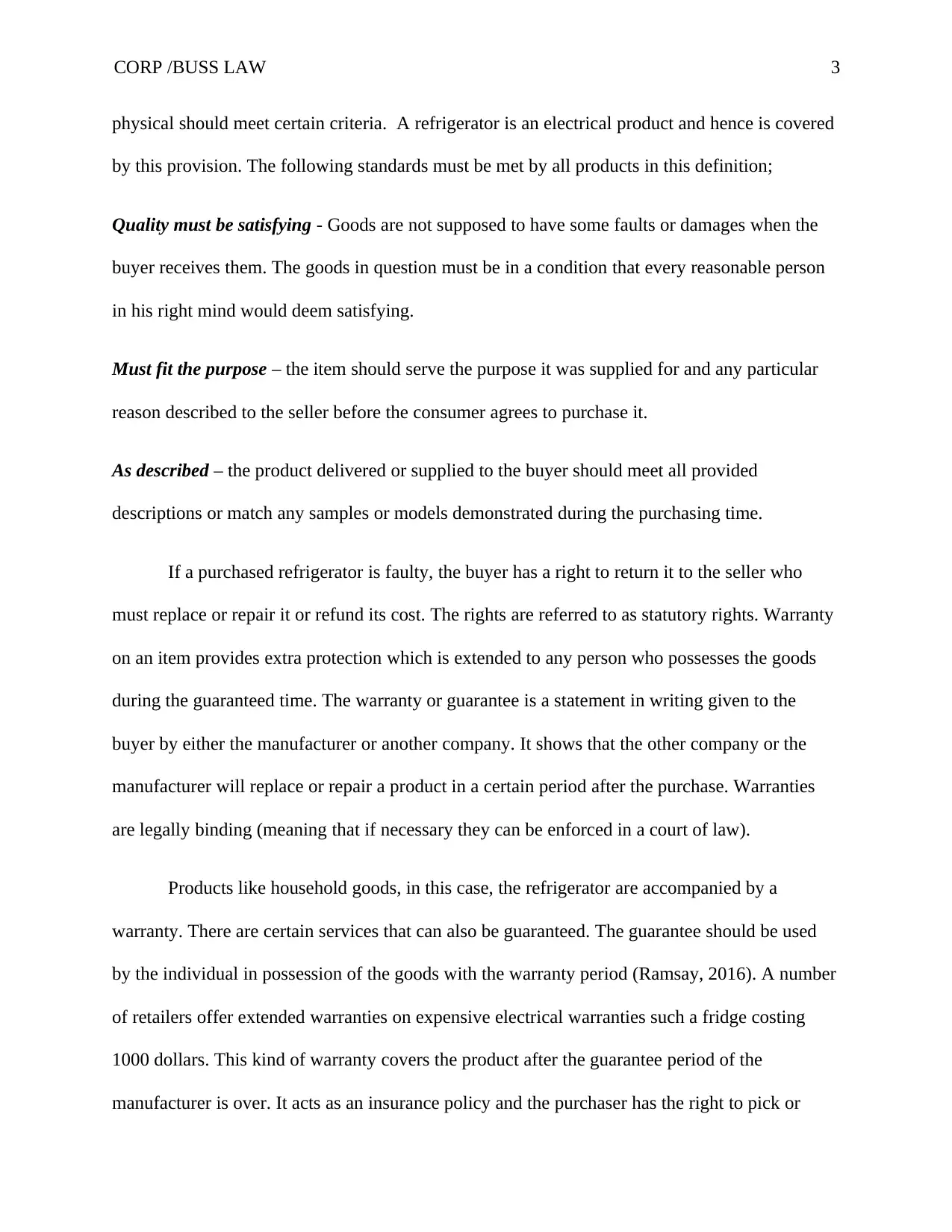
CORP /BUSS LAW 3
physical should meet certain criteria. A refrigerator is an electrical product and hence is covered
by this provision. The following standards must be met by all products in this definition;
Quality must be satisfying - Goods are not supposed to have some faults or damages when the
buyer receives them. The goods in question must be in a condition that every reasonable person
in his right mind would deem satisfying.
Must fit the purpose – the item should serve the purpose it was supplied for and any particular
reason described to the seller before the consumer agrees to purchase it.
As described – the product delivered or supplied to the buyer should meet all provided
descriptions or match any samples or models demonstrated during the purchasing time.
If a purchased refrigerator is faulty, the buyer has a right to return it to the seller who
must replace or repair it or refund its cost. The rights are referred to as statutory rights. Warranty
on an item provides extra protection which is extended to any person who possesses the goods
during the guaranteed time. The warranty or guarantee is a statement in writing given to the
buyer by either the manufacturer or another company. It shows that the other company or the
manufacturer will replace or repair a product in a certain period after the purchase. Warranties
are legally binding (meaning that if necessary they can be enforced in a court of law).
Products like household goods, in this case, the refrigerator are accompanied by a
warranty. There are certain services that can also be guaranteed. The guarantee should be used
by the individual in possession of the goods with the warranty period (Ramsay, 2016). A number
of retailers offer extended warranties on expensive electrical warranties such a fridge costing
1000 dollars. This kind of warranty covers the product after the guarantee period of the
manufacturer is over. It acts as an insurance policy and the purchaser has the right to pick or
physical should meet certain criteria. A refrigerator is an electrical product and hence is covered
by this provision. The following standards must be met by all products in this definition;
Quality must be satisfying - Goods are not supposed to have some faults or damages when the
buyer receives them. The goods in question must be in a condition that every reasonable person
in his right mind would deem satisfying.
Must fit the purpose – the item should serve the purpose it was supplied for and any particular
reason described to the seller before the consumer agrees to purchase it.
As described – the product delivered or supplied to the buyer should meet all provided
descriptions or match any samples or models demonstrated during the purchasing time.
If a purchased refrigerator is faulty, the buyer has a right to return it to the seller who
must replace or repair it or refund its cost. The rights are referred to as statutory rights. Warranty
on an item provides extra protection which is extended to any person who possesses the goods
during the guaranteed time. The warranty or guarantee is a statement in writing given to the
buyer by either the manufacturer or another company. It shows that the other company or the
manufacturer will replace or repair a product in a certain period after the purchase. Warranties
are legally binding (meaning that if necessary they can be enforced in a court of law).
Products like household goods, in this case, the refrigerator are accompanied by a
warranty. There are certain services that can also be guaranteed. The guarantee should be used
by the individual in possession of the goods with the warranty period (Ramsay, 2016). A number
of retailers offer extended warranties on expensive electrical warranties such a fridge costing
1000 dollars. This kind of warranty covers the product after the guarantee period of the
manufacturer is over. It acts as an insurance policy and the purchaser has the right to pick or
⊘ This is a preview!⊘
Do you want full access?
Subscribe today to unlock all pages.

Trusted by 1+ million students worldwide
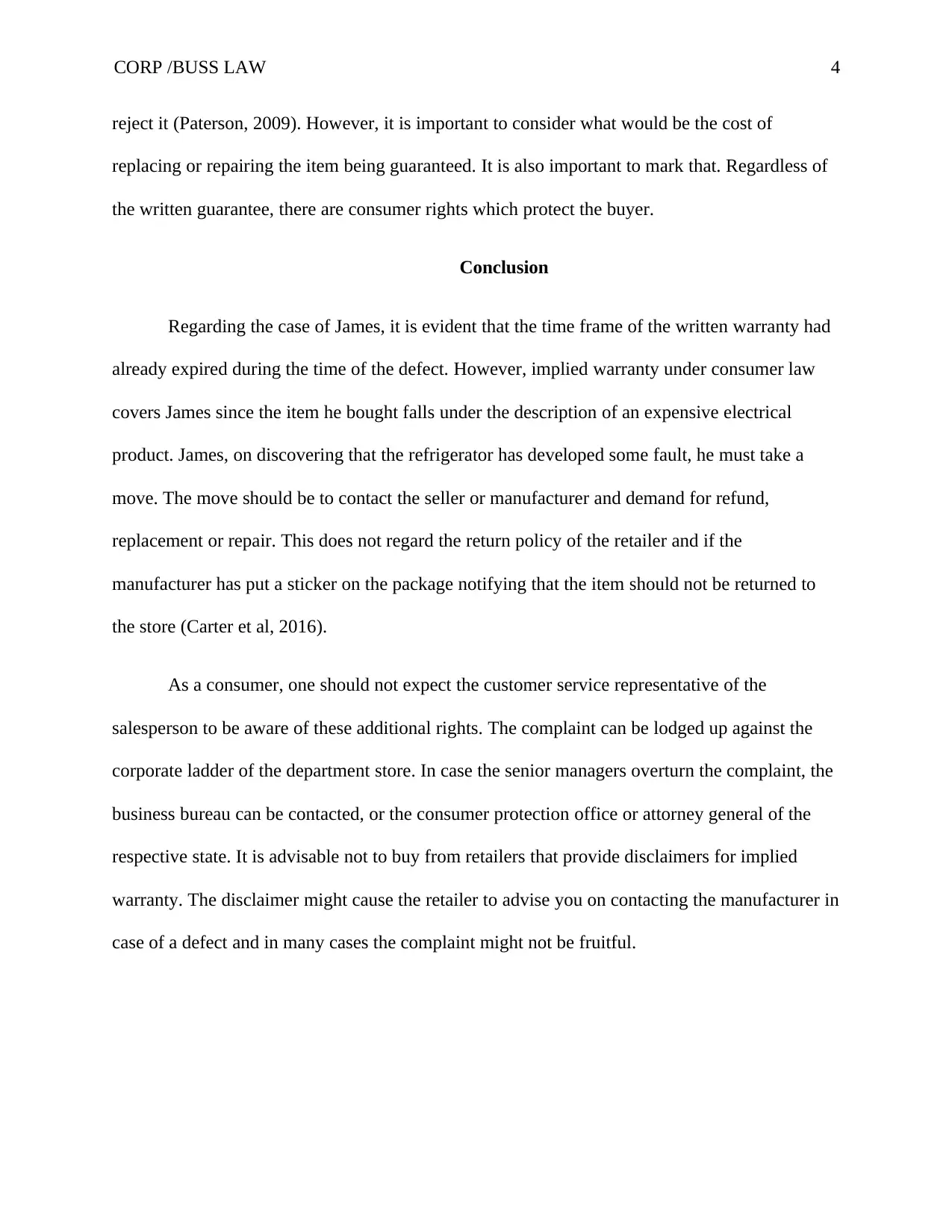
CORP /BUSS LAW 4
reject it (Paterson, 2009). However, it is important to consider what would be the cost of
replacing or repairing the item being guaranteed. It is also important to mark that. Regardless of
the written guarantee, there are consumer rights which protect the buyer.
Conclusion
Regarding the case of James, it is evident that the time frame of the written warranty had
already expired during the time of the defect. However, implied warranty under consumer law
covers James since the item he bought falls under the description of an expensive electrical
product. James, on discovering that the refrigerator has developed some fault, he must take a
move. The move should be to contact the seller or manufacturer and demand for refund,
replacement or repair. This does not regard the return policy of the retailer and if the
manufacturer has put a sticker on the package notifying that the item should not be returned to
the store (Carter et al, 2016).
As a consumer, one should not expect the customer service representative of the
salesperson to be aware of these additional rights. The complaint can be lodged up against the
corporate ladder of the department store. In case the senior managers overturn the complaint, the
business bureau can be contacted, or the consumer protection office or attorney general of the
respective state. It is advisable not to buy from retailers that provide disclaimers for implied
warranty. The disclaimer might cause the retailer to advise you on contacting the manufacturer in
case of a defect and in many cases the complaint might not be fruitful.
reject it (Paterson, 2009). However, it is important to consider what would be the cost of
replacing or repairing the item being guaranteed. It is also important to mark that. Regardless of
the written guarantee, there are consumer rights which protect the buyer.
Conclusion
Regarding the case of James, it is evident that the time frame of the written warranty had
already expired during the time of the defect. However, implied warranty under consumer law
covers James since the item he bought falls under the description of an expensive electrical
product. James, on discovering that the refrigerator has developed some fault, he must take a
move. The move should be to contact the seller or manufacturer and demand for refund,
replacement or repair. This does not regard the return policy of the retailer and if the
manufacturer has put a sticker on the package notifying that the item should not be returned to
the store (Carter et al, 2016).
As a consumer, one should not expect the customer service representative of the
salesperson to be aware of these additional rights. The complaint can be lodged up against the
corporate ladder of the department store. In case the senior managers overturn the complaint, the
business bureau can be contacted, or the consumer protection office or attorney general of the
respective state. It is advisable not to buy from retailers that provide disclaimers for implied
warranty. The disclaimer might cause the retailer to advise you on contacting the manufacturer in
case of a defect and in many cases the complaint might not be fruitful.
Paraphrase This Document
Need a fresh take? Get an instant paraphrase of this document with our AI Paraphraser
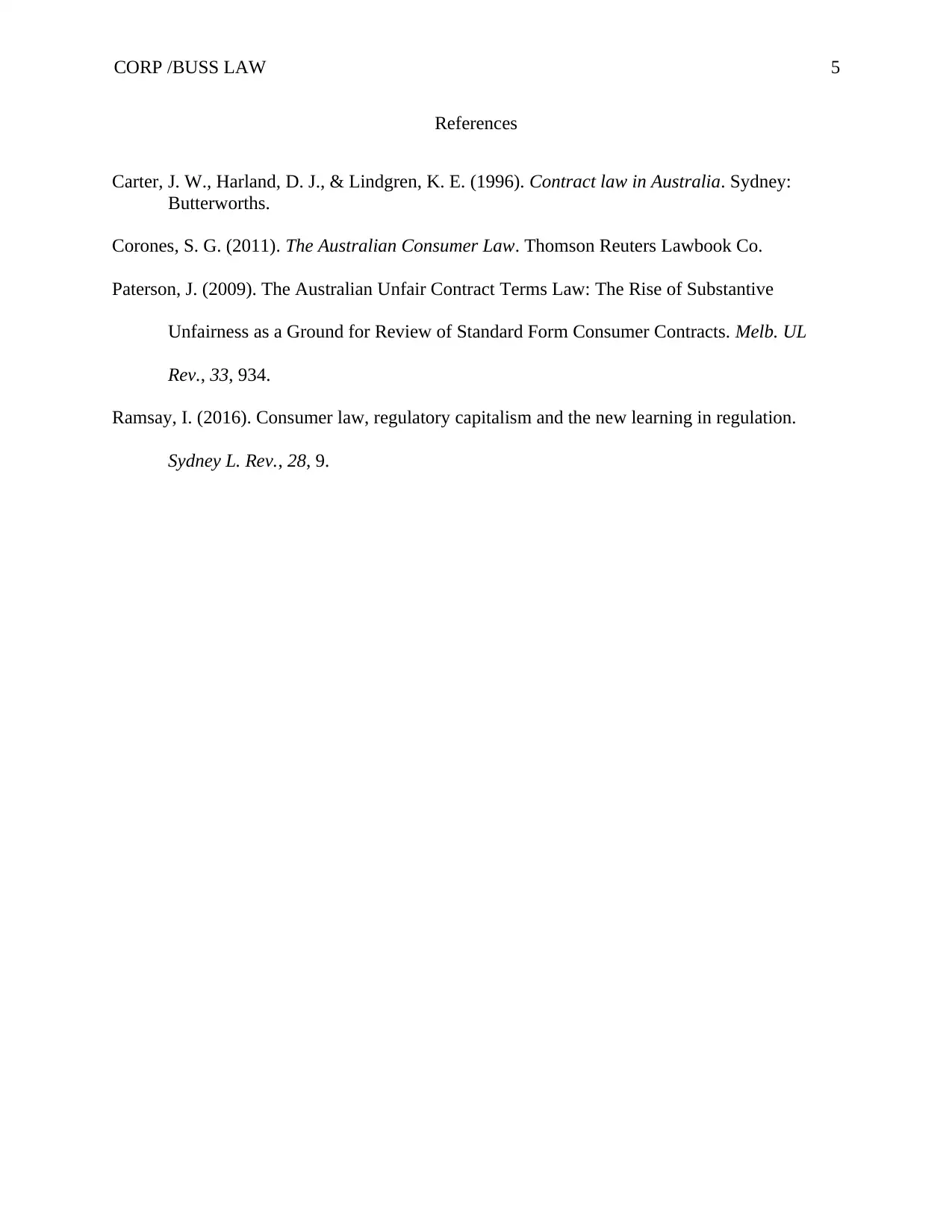
CORP /BUSS LAW 5
References
Carter, J. W., Harland, D. J., & Lindgren, K. E. (1996). Contract law in Australia. Sydney:
Butterworths.
Corones, S. G. (2011). The Australian Consumer Law. Thomson Reuters Lawbook Co.
Paterson, J. (2009). The Australian Unfair Contract Terms Law: The Rise of Substantive
Unfairness as a Ground for Review of Standard Form Consumer Contracts. Melb. UL
Rev., 33, 934.
Ramsay, I. (2016). Consumer law, regulatory capitalism and the new learning in regulation.
Sydney L. Rev., 28, 9.
References
Carter, J. W., Harland, D. J., & Lindgren, K. E. (1996). Contract law in Australia. Sydney:
Butterworths.
Corones, S. G. (2011). The Australian Consumer Law. Thomson Reuters Lawbook Co.
Paterson, J. (2009). The Australian Unfair Contract Terms Law: The Rise of Substantive
Unfairness as a Ground for Review of Standard Form Consumer Contracts. Melb. UL
Rev., 33, 934.
Ramsay, I. (2016). Consumer law, regulatory capitalism and the new learning in regulation.
Sydney L. Rev., 28, 9.
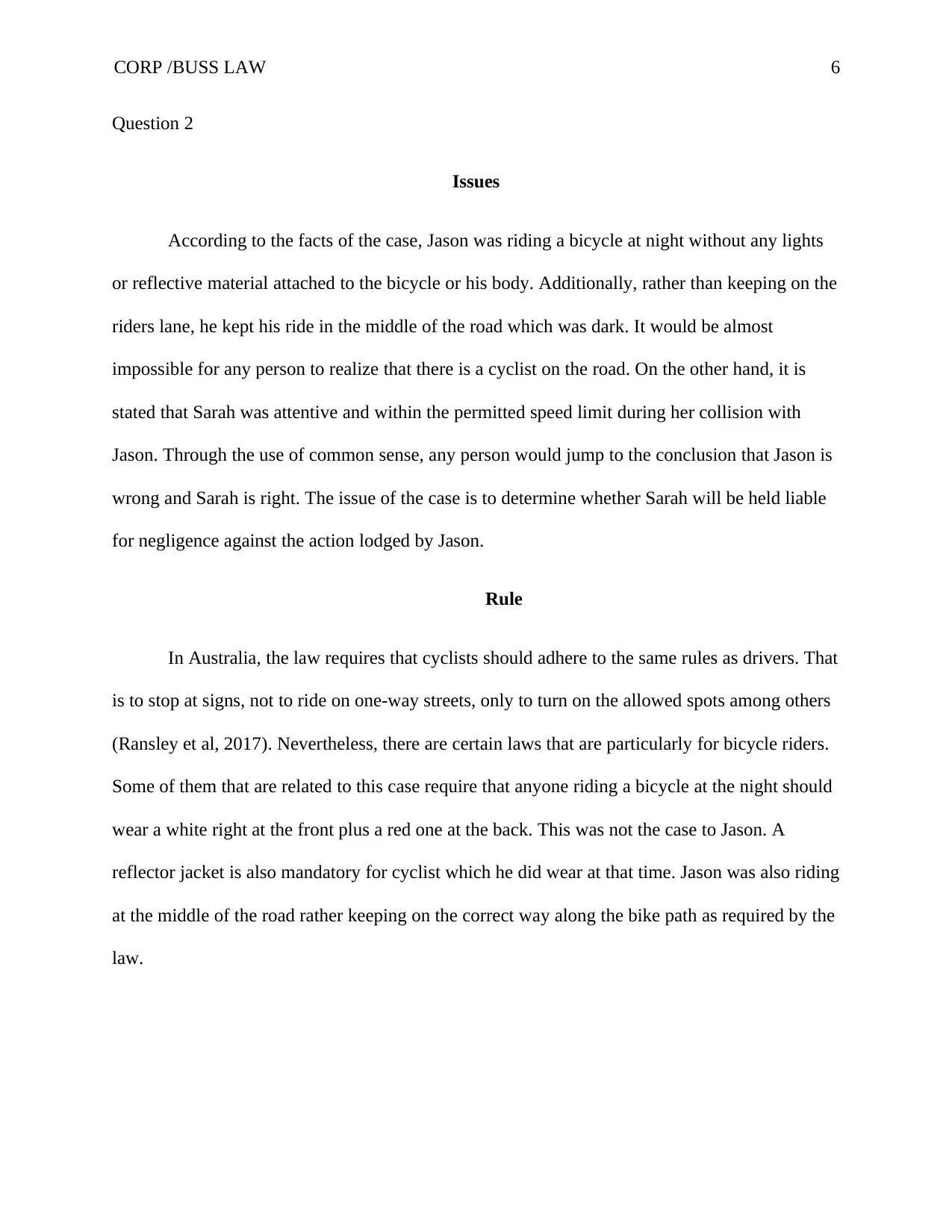
CORP /BUSS LAW 6
Question 2
Issues
According to the facts of the case, Jason was riding a bicycle at night without any lights
or reflective material attached to the bicycle or his body. Additionally, rather than keeping on the
riders lane, he kept his ride in the middle of the road which was dark. It would be almost
impossible for any person to realize that there is a cyclist on the road. On the other hand, it is
stated that Sarah was attentive and within the permitted speed limit during her collision with
Jason. Through the use of common sense, any person would jump to the conclusion that Jason is
wrong and Sarah is right. The issue of the case is to determine whether Sarah will be held liable
for negligence against the action lodged by Jason.
Rule
In Australia, the law requires that cyclists should adhere to the same rules as drivers. That
is to stop at signs, not to ride on one-way streets, only to turn on the allowed spots among others
(Ransley et al, 2017). Nevertheless, there are certain laws that are particularly for bicycle riders.
Some of them that are related to this case require that anyone riding a bicycle at the night should
wear a white right at the front plus a red one at the back. This was not the case to Jason. A
reflector jacket is also mandatory for cyclist which he did wear at that time. Jason was also riding
at the middle of the road rather keeping on the correct way along the bike path as required by the
law.
Question 2
Issues
According to the facts of the case, Jason was riding a bicycle at night without any lights
or reflective material attached to the bicycle or his body. Additionally, rather than keeping on the
riders lane, he kept his ride in the middle of the road which was dark. It would be almost
impossible for any person to realize that there is a cyclist on the road. On the other hand, it is
stated that Sarah was attentive and within the permitted speed limit during her collision with
Jason. Through the use of common sense, any person would jump to the conclusion that Jason is
wrong and Sarah is right. The issue of the case is to determine whether Sarah will be held liable
for negligence against the action lodged by Jason.
Rule
In Australia, the law requires that cyclists should adhere to the same rules as drivers. That
is to stop at signs, not to ride on one-way streets, only to turn on the allowed spots among others
(Ransley et al, 2017). Nevertheless, there are certain laws that are particularly for bicycle riders.
Some of them that are related to this case require that anyone riding a bicycle at the night should
wear a white right at the front plus a red one at the back. This was not the case to Jason. A
reflector jacket is also mandatory for cyclist which he did wear at that time. Jason was also riding
at the middle of the road rather keeping on the correct way along the bike path as required by the
law.
⊘ This is a preview!⊘
Do you want full access?
Subscribe today to unlock all pages.

Trusted by 1+ million students worldwide
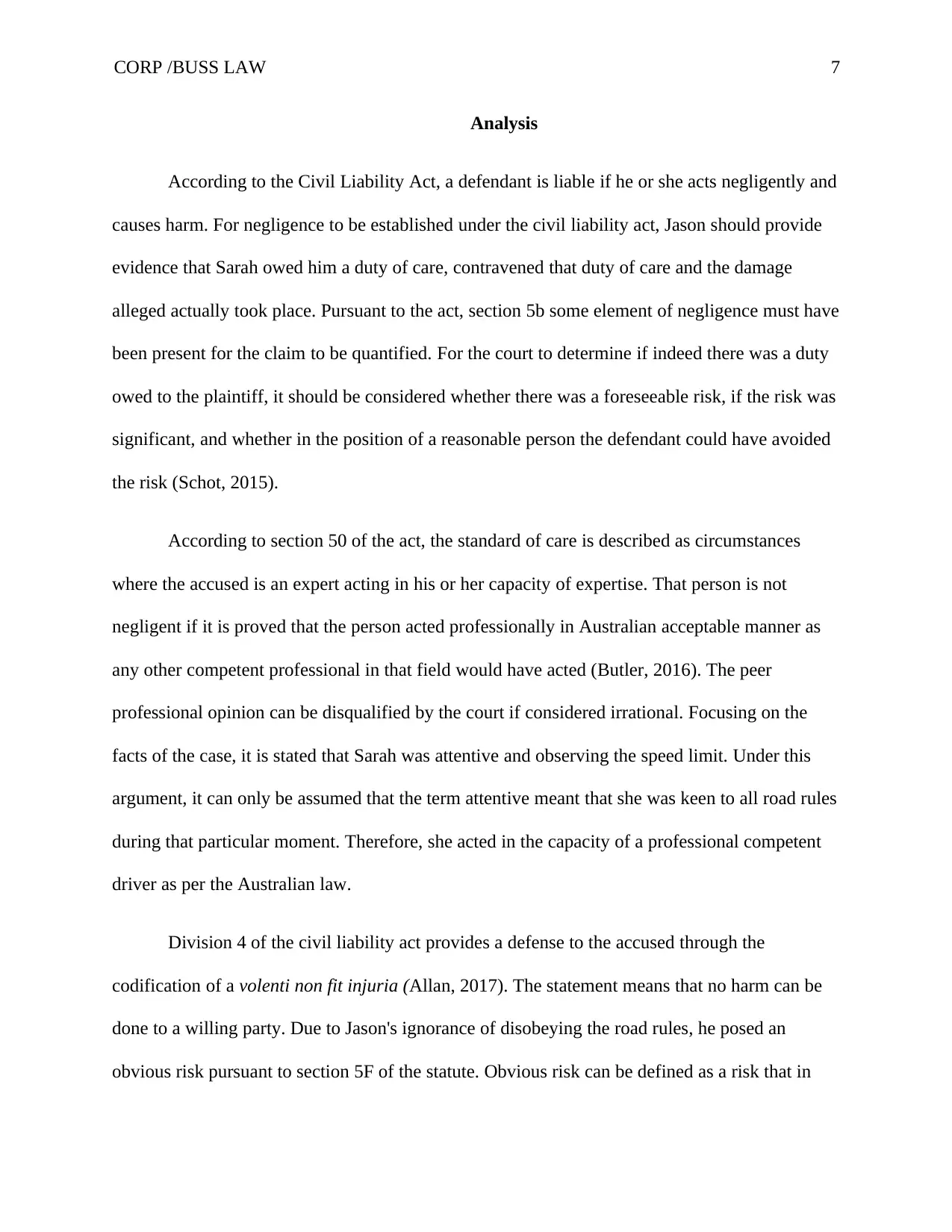
CORP /BUSS LAW 7
Analysis
According to the Civil Liability Act, a defendant is liable if he or she acts negligently and
causes harm. For negligence to be established under the civil liability act, Jason should provide
evidence that Sarah owed him a duty of care, contravened that duty of care and the damage
alleged actually took place. Pursuant to the act, section 5b some element of negligence must have
been present for the claim to be quantified. For the court to determine if indeed there was a duty
owed to the plaintiff, it should be considered whether there was a foreseeable risk, if the risk was
significant, and whether in the position of a reasonable person the defendant could have avoided
the risk (Schot, 2015).
According to section 50 of the act, the standard of care is described as circumstances
where the accused is an expert acting in his or her capacity of expertise. That person is not
negligent if it is proved that the person acted professionally in Australian acceptable manner as
any other competent professional in that field would have acted (Butler, 2016). The peer
professional opinion can be disqualified by the court if considered irrational. Focusing on the
facts of the case, it is stated that Sarah was attentive and observing the speed limit. Under this
argument, it can only be assumed that the term attentive meant that she was keen to all road rules
during that particular moment. Therefore, she acted in the capacity of a professional competent
driver as per the Australian law.
Division 4 of the civil liability act provides a defense to the accused through the
codification of a volenti non fit injuria (Allan, 2017). The statement means that no harm can be
done to a willing party. Due to Jason's ignorance of disobeying the road rules, he posed an
obvious risk pursuant to section 5F of the statute. Obvious risk can be defined as a risk that in
Analysis
According to the Civil Liability Act, a defendant is liable if he or she acts negligently and
causes harm. For negligence to be established under the civil liability act, Jason should provide
evidence that Sarah owed him a duty of care, contravened that duty of care and the damage
alleged actually took place. Pursuant to the act, section 5b some element of negligence must have
been present for the claim to be quantified. For the court to determine if indeed there was a duty
owed to the plaintiff, it should be considered whether there was a foreseeable risk, if the risk was
significant, and whether in the position of a reasonable person the defendant could have avoided
the risk (Schot, 2015).
According to section 50 of the act, the standard of care is described as circumstances
where the accused is an expert acting in his or her capacity of expertise. That person is not
negligent if it is proved that the person acted professionally in Australian acceptable manner as
any other competent professional in that field would have acted (Butler, 2016). The peer
professional opinion can be disqualified by the court if considered irrational. Focusing on the
facts of the case, it is stated that Sarah was attentive and observing the speed limit. Under this
argument, it can only be assumed that the term attentive meant that she was keen to all road rules
during that particular moment. Therefore, she acted in the capacity of a professional competent
driver as per the Australian law.
Division 4 of the civil liability act provides a defense to the accused through the
codification of a volenti non fit injuria (Allan, 2017). The statement means that no harm can be
done to a willing party. Due to Jason's ignorance of disobeying the road rules, he posed an
obvious risk pursuant to section 5F of the statute. Obvious risk can be defined as a risk that in
Paraphrase This Document
Need a fresh take? Get an instant paraphrase of this document with our AI Paraphraser
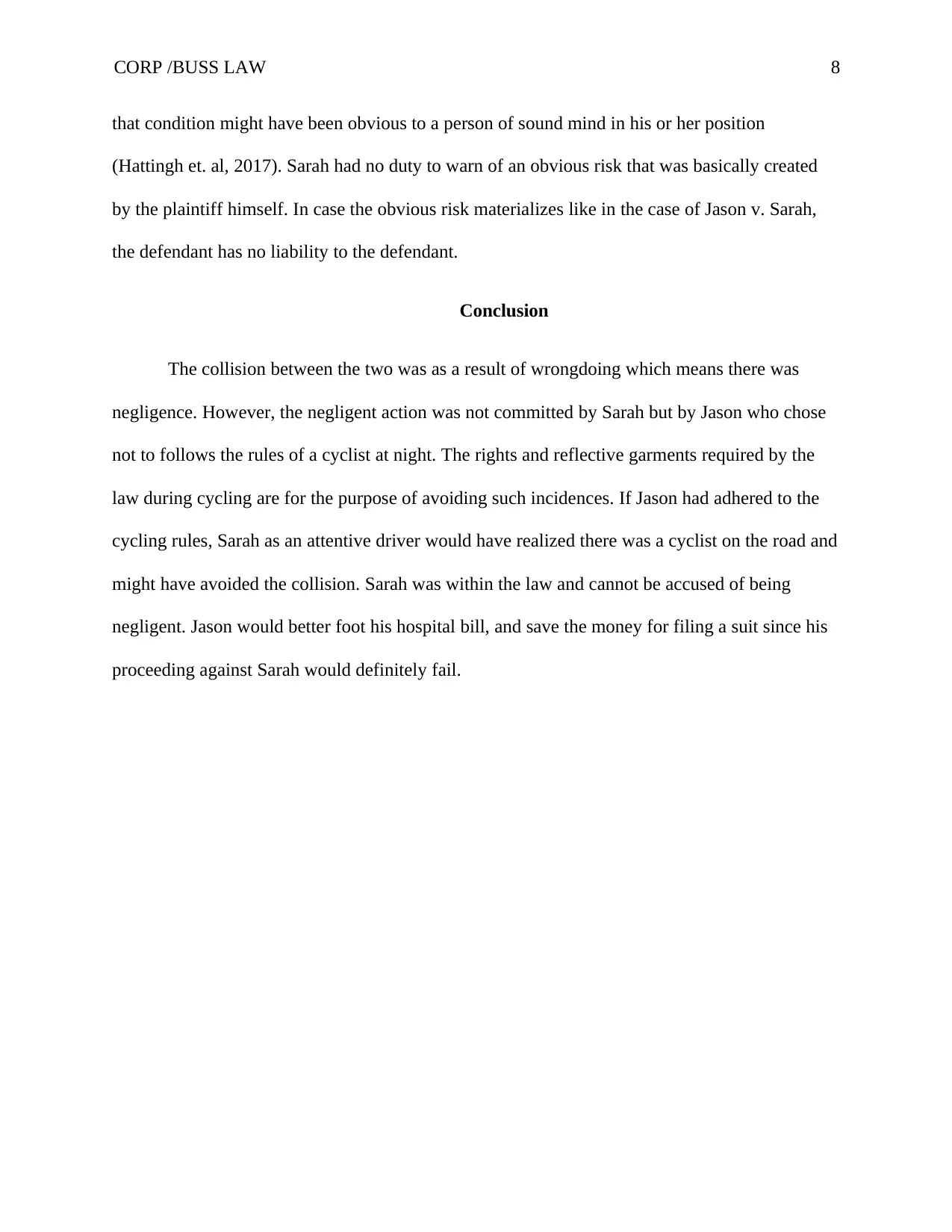
CORP /BUSS LAW 8
that condition might have been obvious to a person of sound mind in his or her position
(Hattingh et. al, 2017). Sarah had no duty to warn of an obvious risk that was basically created
by the plaintiff himself. In case the obvious risk materializes like in the case of Jason v. Sarah,
the defendant has no liability to the defendant.
Conclusion
The collision between the two was as a result of wrongdoing which means there was
negligence. However, the negligent action was not committed by Sarah but by Jason who chose
not to follows the rules of a cyclist at night. The rights and reflective garments required by the
law during cycling are for the purpose of avoiding such incidences. If Jason had adhered to the
cycling rules, Sarah as an attentive driver would have realized there was a cyclist on the road and
might have avoided the collision. Sarah was within the law and cannot be accused of being
negligent. Jason would better foot his hospital bill, and save the money for filing a suit since his
proceeding against Sarah would definitely fail.
that condition might have been obvious to a person of sound mind in his or her position
(Hattingh et. al, 2017). Sarah had no duty to warn of an obvious risk that was basically created
by the plaintiff himself. In case the obvious risk materializes like in the case of Jason v. Sarah,
the defendant has no liability to the defendant.
Conclusion
The collision between the two was as a result of wrongdoing which means there was
negligence. However, the negligent action was not committed by Sarah but by Jason who chose
not to follows the rules of a cyclist at night. The rights and reflective garments required by the
law during cycling are for the purpose of avoiding such incidences. If Jason had adhered to the
cycling rules, Sarah as an attentive driver would have realized there was a cyclist on the road and
might have avoided the collision. Sarah was within the law and cannot be accused of being
negligent. Jason would better foot his hospital bill, and save the money for filing a suit since his
proceeding against Sarah would definitely fail.
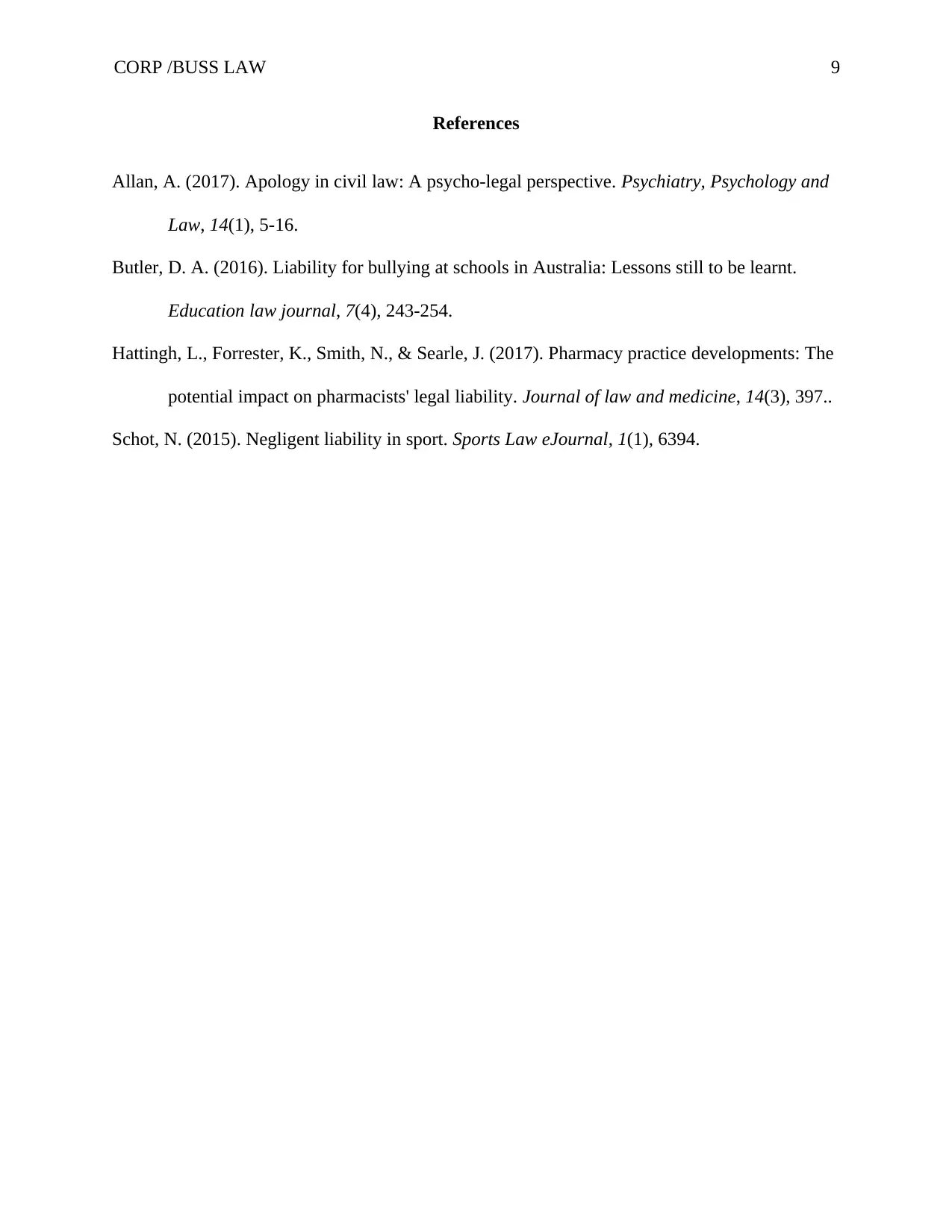
CORP /BUSS LAW 9
References
Allan, A. (2017). Apology in civil law: A psycho-legal perspective. Psychiatry, Psychology and
Law, 14(1), 5-16.
Butler, D. A. (2016). Liability for bullying at schools in Australia: Lessons still to be learnt.
Education law journal, 7(4), 243-254.
Hattingh, L., Forrester, K., Smith, N., & Searle, J. (2017). Pharmacy practice developments: The
potential impact on pharmacists' legal liability. Journal of law and medicine, 14(3), 397..
Schot, N. (2015). Negligent liability in sport. Sports Law eJournal, 1(1), 6394.
References
Allan, A. (2017). Apology in civil law: A psycho-legal perspective. Psychiatry, Psychology and
Law, 14(1), 5-16.
Butler, D. A. (2016). Liability for bullying at schools in Australia: Lessons still to be learnt.
Education law journal, 7(4), 243-254.
Hattingh, L., Forrester, K., Smith, N., & Searle, J. (2017). Pharmacy practice developments: The
potential impact on pharmacists' legal liability. Journal of law and medicine, 14(3), 397..
Schot, N. (2015). Negligent liability in sport. Sports Law eJournal, 1(1), 6394.
⊘ This is a preview!⊘
Do you want full access?
Subscribe today to unlock all pages.

Trusted by 1+ million students worldwide
1 out of 9
Related Documents
Your All-in-One AI-Powered Toolkit for Academic Success.
+13062052269
info@desklib.com
Available 24*7 on WhatsApp / Email
![[object Object]](/_next/static/media/star-bottom.7253800d.svg)
Unlock your academic potential
Copyright © 2020–2025 A2Z Services. All Rights Reserved. Developed and managed by ZUCOL.





